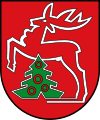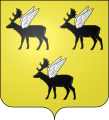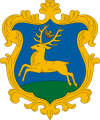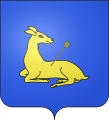Deer (heraldic animal)
The deer is popular in heraldry as a common figure . He is represented very differently in the coat of arms . So he can be walking , lying or standing . In the jumping form, the hind legs must be close together.
Any color is possible for the tinging (heraldic coloring), but the heraldist is often limited to red or black. The natural color rarely occurs. But often gold or silver antlers .
When it comes to blazon , the antlers are particularly important. The number of so-called ends must be emblazoned precisely. The bowed head also has a meaning. The deer would then be grazing . The wide spread as heraldic animal goes back to the possibility to draw talking coats of arms . One example is the town of Hirschberg (Silesia) .
antler
In many cases, only the deer antlers are found in the coat of arms. As a result, many other terms have found their way into the hunt. Deer rods or just rods can be found in the coat of arms descriptions. Often only a single stag pole is shown as a half pole . Several rods are aligned in the same direction. The coat of arms of Württemberg with the three half rods is known. The antlers are also shown with part of the ornamented cranium, the grind .
A deer with a crucifix between the antlers has a symbolic meaning. It stands for St. Hubertus as the patron saint of hunters.
Deer with fish tail
A deer with a fish tail is a rare representation . In the coat of arms of the Lords of Lindenberg there is a red deer head fish in a silver shield.
Examples
The stag was already used as a heraldic animal by Gebhard III. von Hirschberg in a shield-shaped seal in 1253 and also at around the same time by Gebhard IV. (died 1305). See also: Hirschberg (noble family)
rising ( district Alfeld / Leine DE, settlement area of the Cherusci , their tribal name is derived from "cherut" = deer)
striding ( district Sigmaringen DE)
Hirschsprung District High Black Forest (1956–1973) DE
jumping ( Lauscha DE)
left: upright ( Herzberg am Harz DE)
winged fallow deer ( Alzon FR)
Deer cow on Dreiberg ( Gipf-Oberfrick CH)
jumping ten-man ( Klietz DE)
jumping and gold armored ( Lenggries DE)
striding ( Åland FI)
jumping ( Szarvas HU, German Hirschfeld )
walking through a body of water (ford) ( Lend AT)
Growing with the Brandenburg eagle ( Müllrose DE)
floating, cf. Sage ( Angermünde DE)
Three-headed cow ( Cerveteri IT)
Antlers with skull (former municipality of Borgsdorf DE)
walking with Wiederkreuz ( Mertesheim DE)
as sign holder ( Leeuwarden NL)
Doe wounded by an arrow ( Saint-Gilles-du-Gard FR)
See also
literature
- Herbert Cerutti : worries of a top dog. 30 new animal stories. NZZ-Verlag, Zurich 1999, ISBN 3-85823-789-2 .
- Gert Oswald : Lexicon of Heraldry. (From apple cross to twin bars). 2nd, unchanged edition. Battenberg, Regenstauf 2006, ISBN 3-86646-010-4 .
- Georg Scheibelreiter : Animal names and coat of arms (= publications of the Institute for Austrian Historical Research. Vol. 24). Böhlau, Vienna et al. 1976, ISBN 3-205-08509-4 .
Web links
Individual evidence
- ^ Leopold von Zedlitz-Neukirch : New Prussian Adelslexikon: Or genealogical and diplomatic news. Reichenbach, Leipzig 1837.
- ^ Johann Siebmacher : Siebmacher's large and general book of arms. Nuremberg. Volume I, Dept. 2, 1918 and Dept. 1, 1884-1911.




















